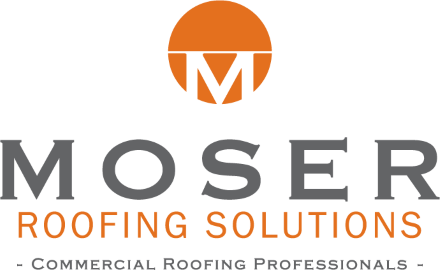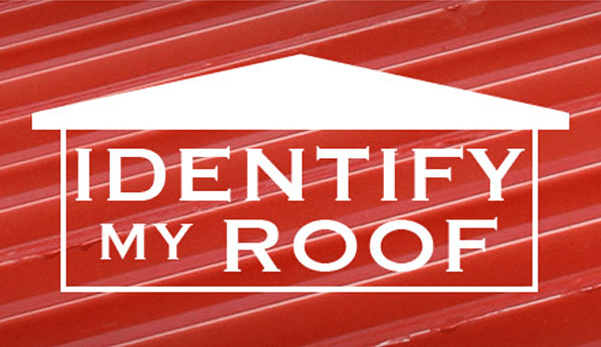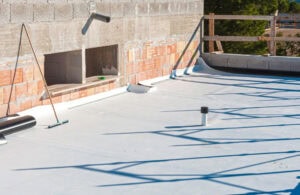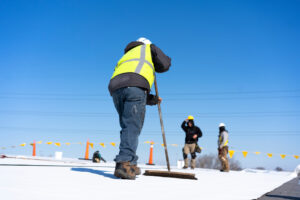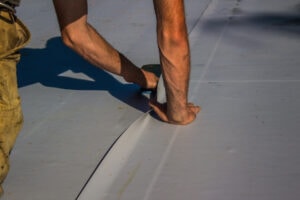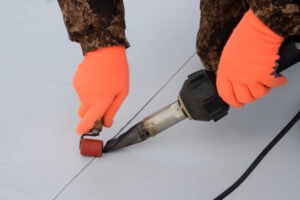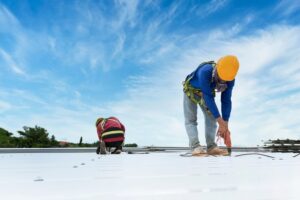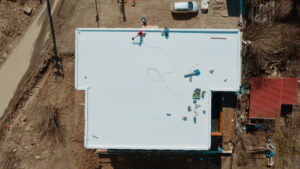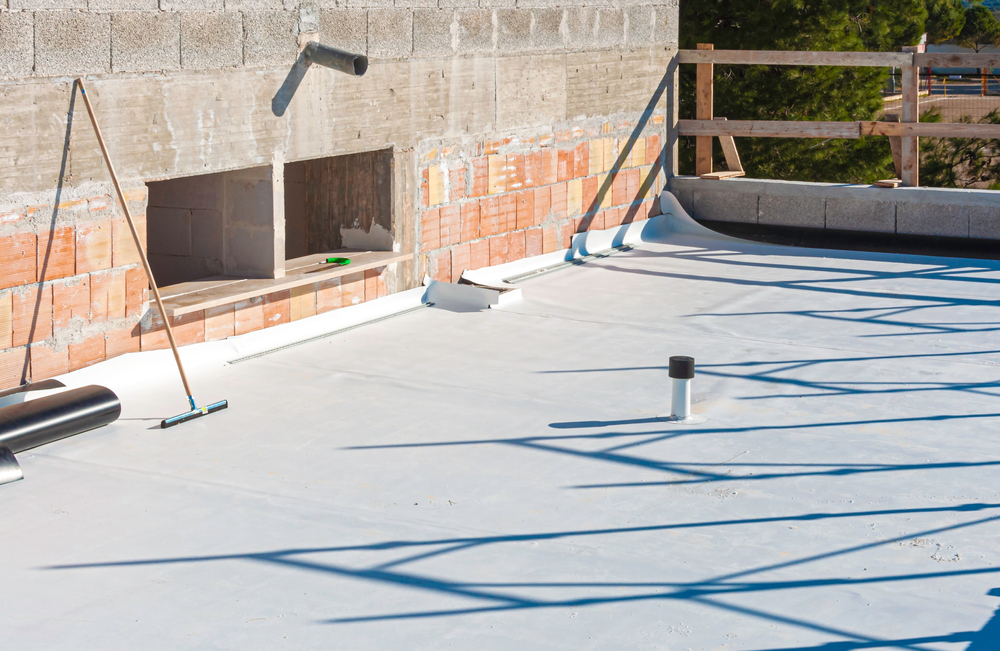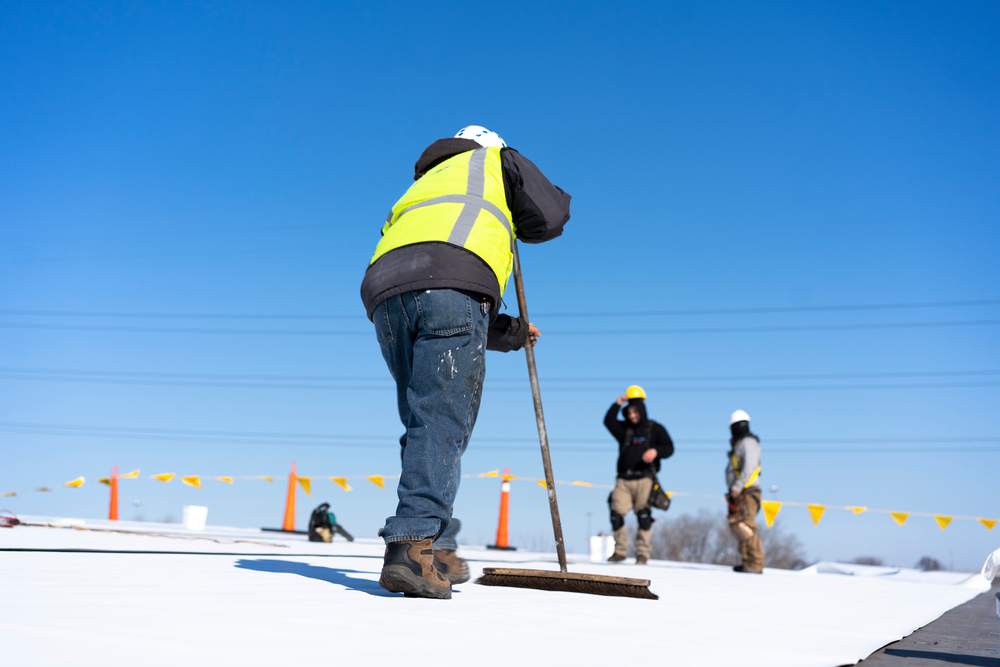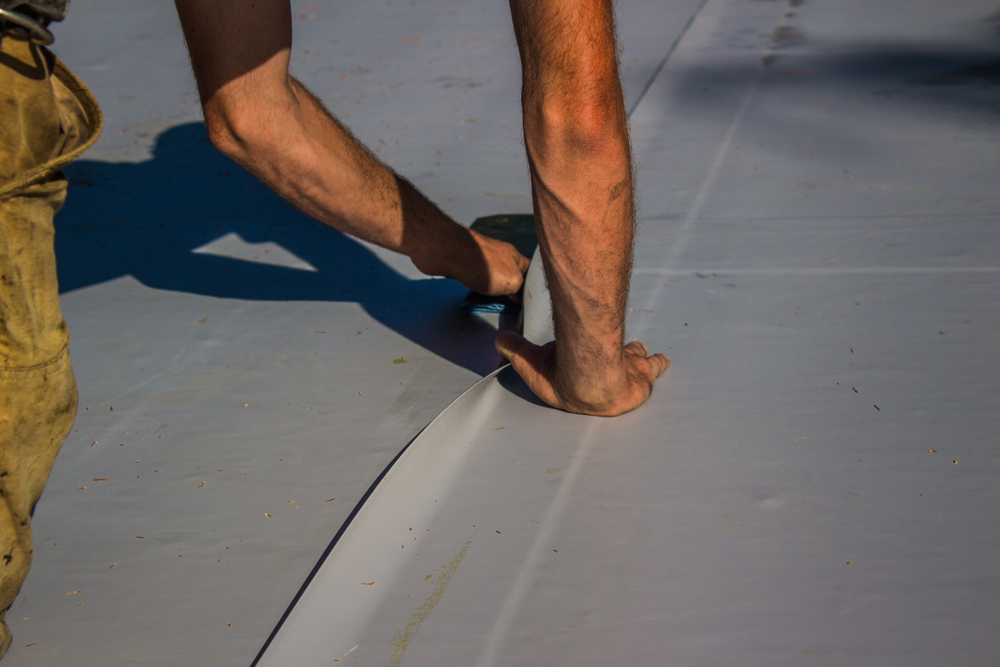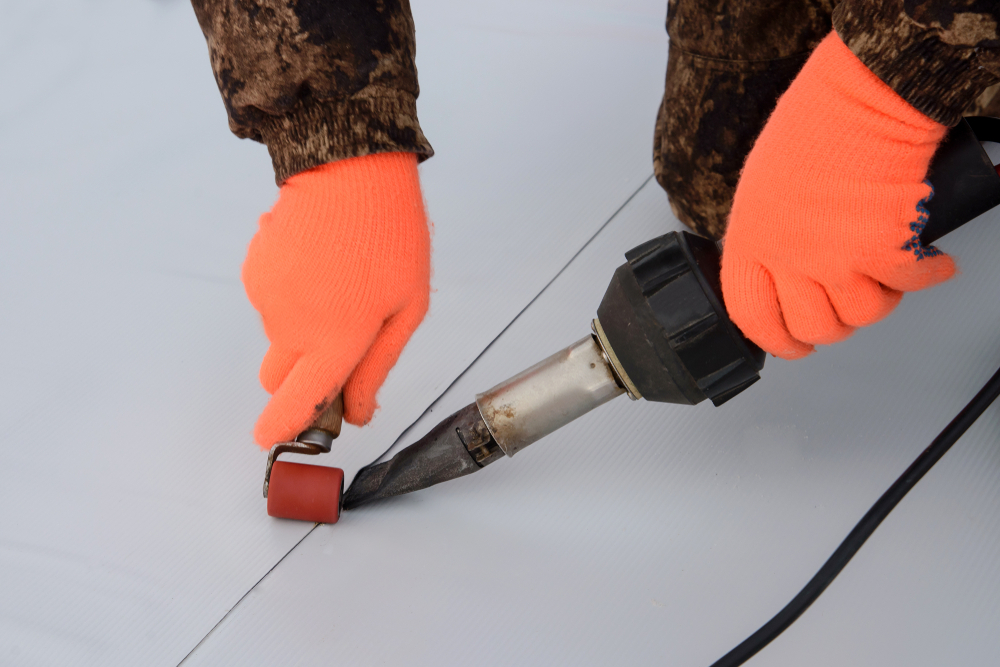Interested in a Commercial Roof Coating? There’s a Lot to Consider
Are you considering commercial roof coatings for repairing or restoring your roof? Before you move forward, make sure you understand the pros and cons of using a commercial roof coating. In recent years, roof coatings have become an alternative option for building owners seeking to replace an entire roof. However, this increased popularity has led to some overuse of roof coatings, even in situations where they may not be the best solution or could even harm the roofing system.
At Moser Roofing Solutions, we offer commercial roof coating services, but we approach each project with careful consideration and analysis to determine if a coating is the most appropriate solution for the specific roof in question. We believe it’s crucial to weigh various factors, including safety considerations, thorough roof pre-installation inspections, and environmental considerations, as well as the durability and structural integrity of the repair or restoration.
If you’re interested in revitalizing your commercial roof with a coating, it’s important to be aware of the key considerations that can make or break a successful project. Before moving forward with a coating, make sure you understand the unique needs of your roof, the installation requirements, and the risks and benefits of using a roof coating. Consulting with a professional roofing contractor can help you weigh the pros and cons of various roofing materials to make an informed decision.
8 Considerations Before Investing in a Commercial Roof Coating
Before investing in a commercial roof coating, there are several considerations to keep in mind. These considerations include the type of repair or restoration materials, the condition of your roof, the climate and weather conditions in your area, safety and environmental considerations and the expertise of the roofing contractor. Taking the time to assess these factors will help you make the best decision for the safety and protection of your roof, your property and your people.
1. Start with an Inspection
A comprehensive roof inspection is always an a crucial step to ensure optimal performance of your commercial roofing system. Prior to undertaking any significant roofing work, we recommend a thorough examination of your roof to gather valuable information that can aid you and your roofing partner in determining the most appropriate solution.
Your roofing expert should evaluate the current state of your roofing system, examining whether it is structurally sound and free of moisture. Is there ponding water? Is thermal shock occurring in the roof assembly? These factors are essential to evaluate before any work begins to ensure that the proposed solution is the best course of action for your roof and building operation.
2. Take Core Cuts of the Roof
When it comes to ensuring the soundness of your roofing system, a mere surface inspection is not enough. To get a more comprehensive understanding of the state of your roof, professional roofers need to rely on core cuts. While core cuts can be time-consuming and are often skipped due to this reason, they are a valuable part of the roofing inspection process.
To perform a core cut, a professional roofer will use a specialized cutting tool to remove a cylindrical section of the roof’s surface down to the decking below. This process allows the roofer to examine the layers of the roof in detail, including the insulation, moisture barrier, and deck.
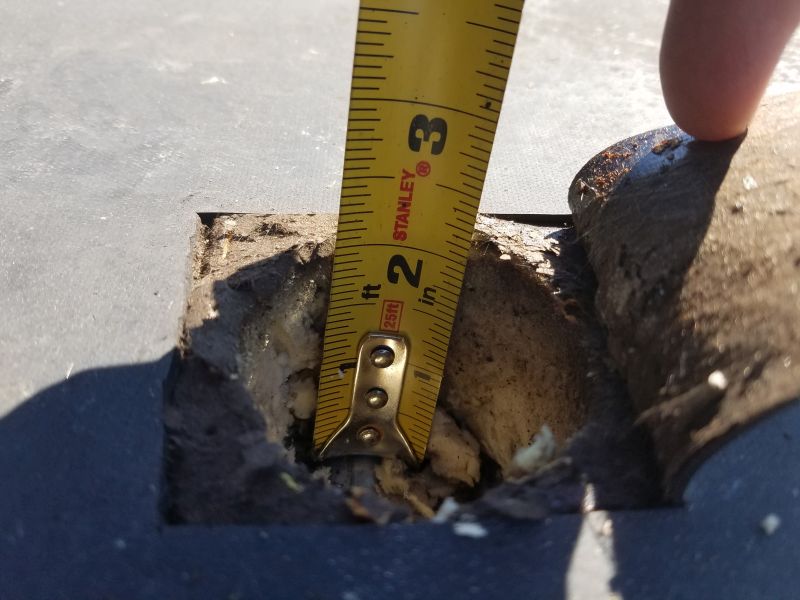
After the core cut has been made, the next step is to patch the hole created by the removal of the cylindrical section. This is typically done using a patch material that matches the roofing system, such as modified bitumen or single-ply roofing membrane. The patch material is applied to the hole, and the edges are sealed to prevent any leaks.
It’s important to note that the patch material used should be of high quality to ensure that it can withstand the elements and last as long as the rest of the roofing system. Additionally, the patch should be applied by a professional roofer with experience in core cuts and patching to ensure that it is done correctly and effectively.
Core cuts are crucial because they can reveal any moisture trapped within the layers of the roof. If left untreated, moisture can cause the roof to degrade over time, potentially leading to deck rot, which is a costly and hazardous issue to address. By detecting and addressing moisture early on, professional roofers can prevent significant damage and save clients’ money in the long run.
The cost to remediate a deck with rot can increase a roof repair or restoration by up to 400%, making early detection and prevention essential. Core cuts are especially important because they can indicate whether the coating on the roof is a good fit or not.
At Moser Roofing Solutions, we recognize the importance of thorough inspections that include core cuts as part of our 32 point diagnostic commercial roofing inspection. By conducting comprehensive inspections, we can provide our clients with accurate assessments of their roofing systems, allowing us to address any issues early on and potentially saving them significant costs down the line.
3. Complete a Full Adhesion Test
Poor adhesion is one of the top causes of failed commercial roof coatings. When a roof coating does not successfully bond with your existing roof’s surface, it enables moisture to seep under the coating, where it will cause water damage and rot to the underlying portions of your roof. For example, this roof below is an example of an adhesion failure:
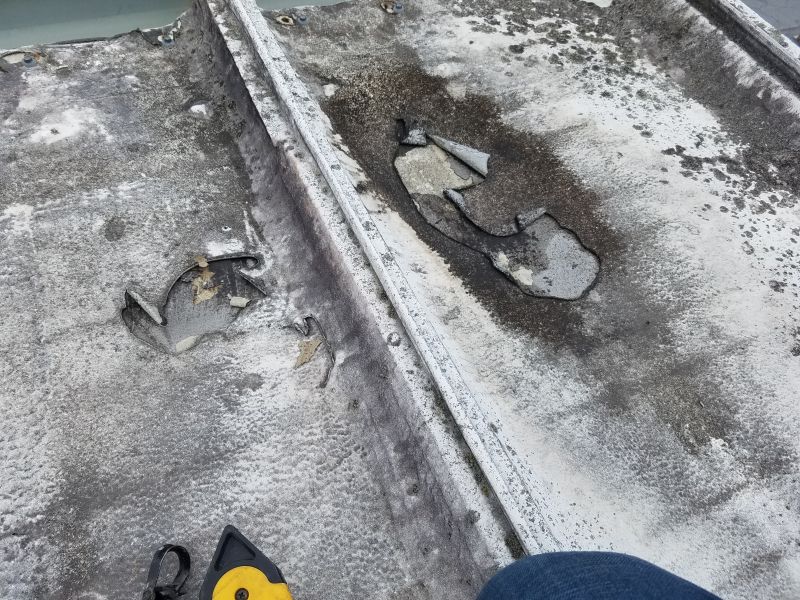
Performing a full adhesion test before installing the roof coating allows you to verify that the coating will bond successfully not only to the primary sections of your roof but also to every section, including those that may have undergone repairs using different materials. If your roof is relatively new, it may not be ready for a roof coating. New roofing requires time and oxidation to avoid delamination, and a pull test will reveal whether your roof is ready for a coating.
Various standards exist for conducting adhesion tests, and each manufacturer has their own standards to be followed when applying a roof coating. It’s important to understand the individual manufacturer’s warranty of the specific coating you are considering, as there are different warranty parameters.
The test typically involves applying a coating sample to a substrate with imbedded fabric, allowing it to cure, and then performing a pull test to measure the force required to remove the coating. An adhesion test determines the effectiveness and durability of a roof coating product.
4. Assess the Slope of the Roof
Before investing in a commercial roof coating, it’s critical to evaluate the slope of your roof to ensure it has proper drainage.
During the inspection, your professional roofing contractor should assess the slope of your roof to determine if it will allow for proper drainage. Standing water is a common issue that compromises the performance of the roof. If the slope is not sufficient, it’s essential to address drainage and ponding issues before proceeding with any repairs.
At Moser Roofing Solutions, we specialize in flat and low sloped commercial roofs, and are ready to help you protect your building.
5. Account for Toxicity
Safety should always at the forefront of any commercial roofing activity. When considering using a commercial roof coating, it’s important to be aware of the safety hazards associated with these products. Many roof coatings contain chemicals that can be harmful to both the roofing team and the building occupants. Taking appropriate precautions is necessary to ensure the safety of all involved.
The toxicity level of different coating products can create a dangerous environment. Roof coatings can release vapors that can be hazardous to breathe, so it’s important to evaluate the toxicity level of the product you choose. If the product is highly toxic, as many roof coatings are, it’s essential to keep fumes from entering into air handling systems to avoid unwanted evacuation of building occupants during installation process. Your roofing contractor should provide personal protective equipment (PPE) for their employees to ensure they are not exposed to the harmful vapors.
Because different coatings have different toxicity levels, it’s important to choose a product that is safe for your building’s occupants and the environment. Adhering to the safety instructions and warnings on the product label, and ensuring that the roofing team takes necessary safety measures and precautions are important steps to help safeguard the well-being of everyone involved in the installation process.
6. Ensure Secure Fall Protection Anchor Points
Roof coating products are often extremely slippery, and can dramatically increase the risk of injury or fall for roofing teams and others on the rooftop. Injuries can occur when roofers lose their footing and fall from the roof. Even slipping and falling on the roof can create serious injury. Consideration must also be given to fall-through risks for skylights. Safety redundancy is often skipped because it is time consuming. To minimize this risk, a fall protection system with anchor points is essential during any roofing project, but it is especially important when dealing with slick materials, like roof coatings.
At Moser Roofing Solutions, we prioritize safety above all else and ensure that our workers are fully secured with a personal fall arrest system. Our commitment to safety is evident in our detailed safety procedures, as featured in this article.
7. Take Precautions During Cleaning
Proper surface preparation is one of the most important steps when installing a roof coating. It helps to ensure effective adhesion and better long-term performance. Cleaning the existing surface of your roof thoroughly helps to prepare the surface by removing any dirt, debris, or loose materials that could affect the adhesion of the coating. During the cleaning it’s also important to make sure you don’t create a blow off situation that compromises the integrity of the existing roof system.
After cleaning the surface, ensure that the roof is smooth and even. Remove any existing adhesion barriers such as coatings, adhesives, or other materials that may be on the roof’s surface. A clean, even surface is essential to achieving proper adhesion and a uniform appearance of the roof coating.Inspect the roof for any issues that could affect the coating’s performance, such as cracks, leaks, or areas of poor drainage. Any areas with visible rust, corrosion, or damage should be repaired before installing the roof coating. Taking the time to identify these issues before installing the roof coating can prevent future problems and ensure the coating’s longevity.
Next, select and apply the right primer or primer substitute for the roof coating. The primer ensures that the coating adheres to the surface properly, providing long-lasting protection against environmental factors such as UV radiation, moisture, and temperature fluctuations.
Finally, keep in mind that the runoff from cleaning your roof needs to be disposed of correctly, as there may be toxic or dangerous chemicals involved in the preparation process. Before beginning the surface preparation, discuss with your roofing contractor how the gray water from cleaning will be managed and disposed of to prevent contamination from runoff and avoid any potentially harm the environment and your building’s water supply.
By taking these precautions, you can ensure a successful installation of your roof coating while maintaining environmental safety and protecting your building’s water quality.
8. Wait for Ideal Installation Conditions
Proper installation conditions are crucial for the successful application of a commercial roof coating. This process requires ideal weather conditions for several days, with a critical need for minimal moisture. Before the installation, the roof must be thoroughly pressure washed and dried to prevent any moisture from getting trapped between the coating and the substrate.
Humidity levels also play a significant role in roof coating installation. High humidity levels can interfere with the adhesion and curing process of the coating. Ideal installation days are those with low humidity levels to ensure optimal conditions for the coating’s performance.
Wind can also be a significant factor in roof coating installation. Sprayed coatings require relatively calm conditions, and wind speeds above 5 MPH can interfere with the quality of the coating application or cause overspray onto surfaces other than the roof itself.
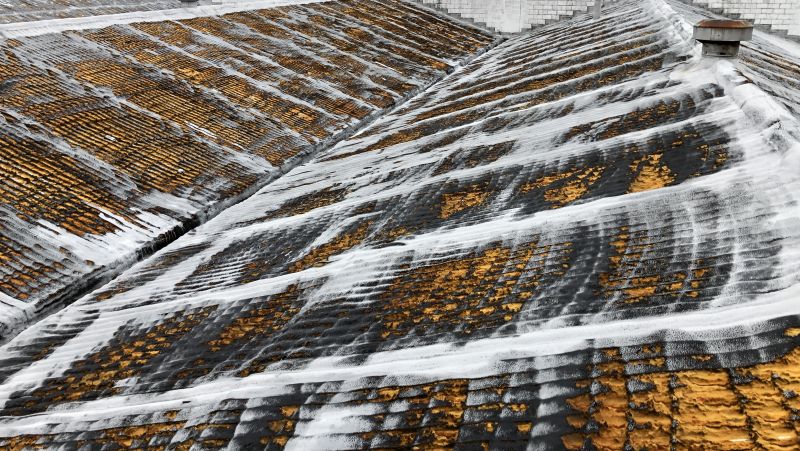
12 Questions to Make Sure You’re Hiring the Right Roofer
How can you be sure that the roofer you hire to repair, restore or replace your commercial roof will go through all of the important procedures required? That’s where our additional consideration comes in. Ask the right questions to make sure you’re getting the right commercial roofing specialist for the job.
1. What Is Your Follow-Up Process After the Sale Is Complete?
Following completion of the sale, your roofer should consult with you to schedule a thorough pre-installation inspection. They should also coordinate with you to plan out the installation process, including necessary surface prep and other pre-installation procedures. This will help to minimize disruptions to your day-to-day operations.
2. Do You Have a Preventative Maintenance Department?
Proper maintenance is crucial for getting the most from a flat or low-slope commercial roof. When installing a commercial roof coating, maintenance becomes even more important for avoiding potential issues down the line. You want to make sure that your professional roofer is around and available for follow-up and preventative maintenance after the initial work is done. Not doing preventative maintenance can lead to a failure that can go undetected until the problem becomes severe.
3. Are You Local?
Local companies make ideal commercial roofing partners. They can respond more quickly and will be better established within your community, meaning you can better assess their reputation, gain access to local manufacturers and distributors, and much more.
4. How Much Experience Do You Have With the Materials?
It’s never a good idea to hire an inexperienced roofer, but given the precise installation process required for a successful commercial roof coating, specialized experience installing your preferred product goes a long way.
5. How Many Years Have You Been in Commercial Roofing?
General industry experience is also valuable. The more experience a commercial roofer has, the better equipped they will be to provide thorough inspections, necessary repairs, and recommendations for maximizing the performance of your roofing system.
6. Can You Provide Referrals from Previous Commercial Roof Coating Customers?
Referrals are great—referrals from clients who had the same product you want installed by the same roofer are even better. If past customers are satisfied with their experience, and their coating performed well throughout its expected lifespan, it’s a good sign that you can trust the roofer.
But, just as important as the success stories, make sure you ask about the most challenging roof outcome, why it happened, and how it was resolved. If there are no missteps, then the roofer may not be telling you everything. You can judge a roofing company from their stories of integrity, where they took a challenging situation and made it right.
7. Are You Insured? Does Your Insurance Company Cover Overspray?
It’s crucial to make sure that any roofer who works on your building is fully insured. Uninsured roofers leave you liable in the event that damage or injuries occur during installation—and with so many safety protocols needed for commercial roof coatings, this question becomes even more important.
For coatings that are sprayed onto your roof, you should specifically ask about coverage for overspray. This is a rider on most insurance policies, meaning it isn’t typically covered by default. Instead, the roofer must specifically add it to their policy.
8. Are You Using Subcontractors?
When you hire a roofing company, it’s important to make sure if they use subcontractors, the subcontractors certified by the manufacturers of the roofing product being installed.
9. What’s Included in Your Commercial Roof Coating Inspection?
Given what we’ve covered above, you should make sure that any commercial roofer offering to install a commercial roof coating will first complete a thorough inspection. That inspection must include moisture testing, core cuts, and a full adhesion test on all portions of the roof. A thermal imaging scan is also a valuable part of a thorough pre-installation inspection.
10. Is There Ponding Water on My Roof?
If you observe ponding water on your commercial roof, it’s a red flag indicating potential issues. Before opting for a commercial roof coating, prioritize addressing the underlying problem with a thorough flat roof repair. Ponding water can compromise the coating’s effectiveness, making proper repairs a crucial first step for a durable solution.
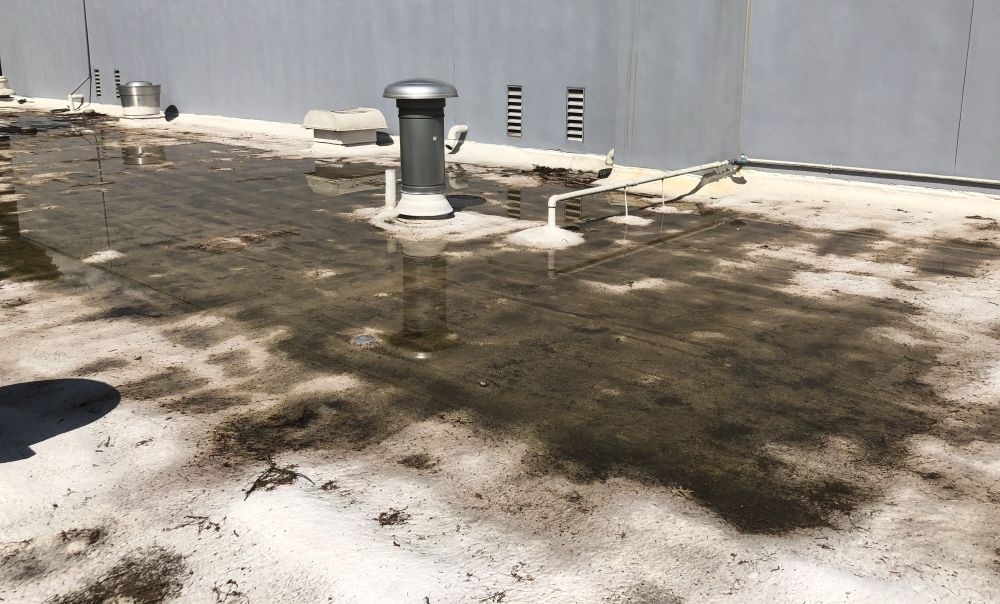
11. What Are the Detail Requirements Understood of the Roof Solution?
Your commercial roofing partner should communicate all installation requirements for the chosen product. If all necessary requirements for your type of roof cannot be met, you should reconsider a different roof solution.
Even if a commercial roof coating is applied, it is incumbent upon your roof contractor to make sure manufacturer required millage has been achieved and verified by the manufacturer during the application process. This requires a core cut and repair or an electronic measuring device. The millage of the initial coating may change after the coating has fully dried. If the millage is not sufficient, the manufacturer’s warranty may be voided. Even worse, premature failure may occur from not taking the time to review the appropriate application of the commercial roof coating.
12. Do You Have the Right Roof Warranty?
Has the contractor provided a sample warranty? Explained warranty limitations? Will the contractor honor the warranty if the manufacturer rescinds warranty enforcement?
We’ll Help You Determine the Ideal Solution for Your Roof
Many roofers present commercial roof coatings as an ideal solution for any roof. They claim that a coating can be installed very quickly and will fully restore your roof for many years at a fraction of the cost of a roof replacement.
Unfortunately, the quality of commercial roof coating installations can be severely lacking, and result in ongoing issues in coating systems. Proper installation of a roof coating requires roof inspections before and after, applications and reapplications if needed, and time consuming application measurements and review. By the time a commercial roof coating solution is successfully completed, it may no longer be the most cost effective option.
At Moser Roofing Solutions, we believe in providing commercial roofing solutions that fit our customers’ building and budget. We provide commercial roof coating services, but only when it is truly the ideal solution for our customers—and determining the ideal solution starts with a thorough inspection and assessment of your needs.
If your commercial roofing system is failing and is not keeping you dry, get in touch with the Moser team today! We’ll work with you to identify the solution that will maximize the performance and value you get from your roof for years to come.
